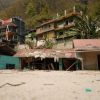Friday, April 26, 2024
News and Views from the Global South
NEPAL: Student Unrest May become Agitation against Gov’t, Monarchy
Damakant Jayshi
- Just like in the seventies and the nineties, the student agitation now raging in Nepal may again shape the political landscape in this Himalayan kingdom.
The unrest in 1979 and 1990 caused major changes in the country – in 1979, the then king was forced to adopt some semblance of democracy and in 1990, multi-party democracy was restored in the world’s only Hindu kingdom.
The agitation by eight student organisations, ignited by an increase in fuel prices by up 64 percent on Mar. 25, promises not to be any different.
The unrest may well lead to wider political protests, challenging the government of Lokendra Bahadur Chand appointed by the king – and the monarchy itself – because many Nepalese already feel that the country’s multi-party democracy is under threat.
Girija Prasad Koirala, president of the opposition Nepali Congress (NC) party, said instability is being caused by the monarchy, which put the current government in place. "If there is any power centre which sets in instability in the country, it is the royal palace and the institution of monarchy," he said.
The political environment in Nepal has been charged since October, after the king intervened and dismissed parliament. He later installed the current government, which political parties call unconstitutional and illegal because it is not legitimately elected one.
The fear of multi-party democracy is not unfounded, many say, considering that King Gyanendra never refers to ”multi-party parliamentary democracy” in his various addresses, and says that he is committed to democracy.
The Maoists too have rejected the present model of democracy in Nepal. In the war they have waged for more than six years now – and for which initial peace talks were postponed Monday – their aim is to overturn the constitutional monarchy and put in place a republican system.
Seen in this context, many fear that the student protests have all the ingredients of becoming a wider call for change. Nepal’s political parties, chafing at the current government, are just short of joining the rampaging students on the streets.
"We are soon going to take the lead from the students, just like in the past," said Nepali Congress spokesperson Arjun Narsingh KC. "It is not about petroleum products’ prices’ hike anymore. The agitation will now focus on political dimensions."
The Nepali Congress and three parties are expected to announce a joint movement in early May. "The marginalisation and defaming of the parties will prove costly to those who attempted it," thundered Arjun Narsingh KC.
Madhav Kumar Nepal, general secretary of the Communist Party of Nepal (unified Marxist-Leninistm said the parties opposed to ”unconstitutional government” would soon join the students in their protest against ”forces of regression”.
Even the students seem to agree that the protests are more than just the price hike and the postponed student body elections that they have demanded.
Already, the agitation has turned somewhat violent. A student leader, Devilal Poudel, died on Apr. 8 in the western town of Butwal, others have been arrested and the protests have led to the dismissal of three cabinet-ranked ministers, including those holding the home and education portfolios.
On Apr. 20, the government brought down, marginally, the prices of the kerosene, diesel and aviation fuel. But this might be too little, too late. No less than the chiefs of the two of the major student organisations warn of serious consequences for the royal household.
"Even if the government rolls back the price to pre-hike status and holds the elections to the student body, our movement would not stop," said Gururaj Ghimire, president of Nepali Congress-affiliated Nepal Students’ Union (NSU). "Rather the focus will now be the king who is seen as authoritarian. There is absolutely no question of halting the protests without major changes."
His sentiments are echoed by leftist student organisations, a bitter rival of the NSU for the student union polls that were earlier scheduled to be held Apr. 23. Rajendra Rai, general secretary of the CPN-UML affiliated All Nepal National Free Students’ Union minces no words against the government and the monarch.
"It is most likely that the monarchy could become the target of the current agitation," said Rai. "Since the king has taken upon the executive powers himself, he will naturally be the target of unrest."
Ghimire and Rai have rejected the marginal reduction of prices of petroleum products as a "farce".
There could be a repeat of the past when the students began an agitation and later, the parties took over. The years 1979, 1990 and 2003 have a common thread: student- police confrontation that led to nationwide flare ups.
The hanging of Pakistan’s former president Zulfikar Ali Bhutto on Apr. 4, 1979 led to widespread protests, after the students who had gone to hand over a protest memorandum to the Pakistan Embassy were baton-charged by the police.
The protests that followed brought the country to a standstill, forcing then King Birendra, the current monarch’s elder brother, to announce a referendum on the much-hated and party-less system of governance through the ‘panchayat’ (village councils).
In March 1990, the people’s movement to restore multi-party democracy was in a lull when the stabbing of a student fuelled the nation-wide movement, later reading to the restoration of multi-party democracy.
The student protests have already given jitters to Chand government, amid talk that it might now be replaced.
But Krishna Hachhuthe, political analyst with the Centre for Nepal Asian Studies under Tribhuvan University, does not agree with that a bigger battle necessarily lies ahead. ”The students are only in the forefront. The whole movement is being run by the parties."
Just like Bhutto’s hanging, the petroleum products’ price hike is a mere excuse to launch broader political agitation, he said. "The parties who have not been able to seriously oppose the royal moves are seeing an opportunity in student unrest. The origin and the end of the ongoing protests are the parties, and not the students," Hachhuthe explained.
It all depends on whether the political parties come out firing all their cylinders, he said.

 Print
Print



